The Museum Collections
Introduction
I. History and Art Collection
1. Icons of the 14th – 19th centuries
icons of the 14th – 17th century
2. Jewelry art of the 14th – 20th century
jewelry art of the 14th – 17th century
jewelry art of the 18th – 19th century
the european silver 14th - 19th centuries
3. Small-size sculptures (works of metal, wood, bone)
XI – the beginning of the XX century
Small-size sculptures 11th – 17th century
Small-size sculptures 18th – early 20th century
enamel of Troitza masters 15-8th – early 20th century
5.Embroidery, lace, textiles of the 14th - early 20th century
icon and ornamental embroidery
gold and silver lace
6.Painting of the 18th – 21st centuries
painting of the 18th – 19th centuris
painting of the 20th – 21st centuris
II.Manuscripts and old printed books of the 14th – 17th century
IV.Lithography of the 18th – 19th century
V.Numismatics
VI.Medals of the 18th - early 20th century
VIII.Archeology collection
IX. Russian folk and applied and decorative art of the 17th – 21st c.
1. Artistic wood
folk carved and painted wood
wooden toys
house carving of Sergiev Posad
Khokhloma and Gorodets painting
2. Artistic textiles
embroidery and weaving
printed textiles and lace
Russian shawls
folk costumes
folk garments
printed cotton kerchiefs
|
Small-size Works of the 11th – 17th Centuries (page 1) |
Miniature carvings in stone, wood, bone, mother-of-pearl constitute an interesting part of the ancient collection. They are mainly various church objects: small icons, crosses, panagias that were wide-spread since ancient times. Made to individual order by professional artisans, they were always of special value for their owners. They were believed to be protectors that could defend people in possible troubles and guard their lives. Generally these icons and crosses were decorated with precious mountings. Like painted icons, embroidered icon-cloths and palls, miniature works were greatly appreciated and often donated to the monasteries. Their content demonstrates the great variety of Russian iconography. The main part of the collection comprises the 14th – 17th century works, but there are single items referring to the earlier period of the 11th – 13th centuries.
The Sergiev Posad Museum-Reserve possesses one the most comprehensive collections of this kind in our country, including the best samples of this kind. The surviving Monastery documents permit to date many items precisely, as well as, to reveal the symbolic meaning of the subjects they depict. The collection demonstrates the sequential development of Moscow craft and presents quite a number of interesting works connected with Ryazan, Vladimir and Suzdal, Novgorod and Tver.

The Virgin Hodigitria and St. Nicholas of Zaraisk.Pectoral icon. 13th century. Ryazan. Obverse (left). Reverse (right)) |
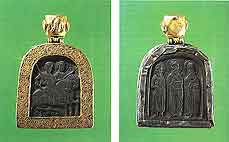
SS Boris and Gleb, Feodor, Nicholas and Grigory. Pectoral icon. First half of the 14th century. Murom. Obverse. Reverse
|
The historical significance of particular samples and their belonging to representatives of different categories of the society determined the place of their preservation. Pectoral crosses and icons, as family “relics” sometimes depicting saints patrons, were fixed on the mountings of the most venerated icons. There were many such appendages on the icons depicting “The Trinity” and “St. Sergius and the Scenes from his Life” in the iconostasis of the Trinity Cathedral. The pectoral icons, crosses and panagias of the Monastery higher clergy were kept in the Monastery sacristy. The Monastery Treasury contained donations of the ostiaries and beadles, the Trinity elders and parish priests. A lot of items including miniature sculptures, confiscated from the disgraced princes and boyars, were preserved in the “Novgorod basket”.
The earliest part of the collection includes stone icons of the 13th – 14th cc. made of soft shale, slate and talcum. Miniature sculptures of that time, preserving pre-Mongolian traditions and showing distinct features of separate artistic schools, are of different style. The limited, yet characteristic group of images included the Virgin, Christ, St. Nicholas, SS George and Nikita.
|
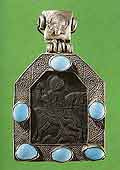
St. George. Pectoral icon. 14th century. Novgorod |
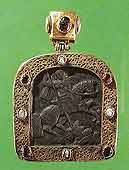
St. George. Pectoral icon. 14th century. Novgorod |
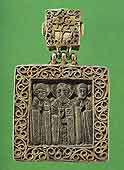
St. Nicholas, SS Cosmus and Damian. Pectoral icon. 14th century. Novgorod |
The iconography of Moscow small-size sculptures reflected locally worshipped, patron saints and most popular church feasts. Stone icons with a carved image of St. George on horseback were wide-spread. This saint worshipping in Moscow Principality was probably connected with the name of Prince Yuri Dolgoruky. (the Long Armed) – the founder of Moscow. He constructed a number of churches, dedicating them to his patron saint, i.e. to St. George. The Moscow works frequently showed St. George on horseback on one side and St. Nicholas of Myra Lycia on the other. Such is one of the early slate icon of the 14th century.
|
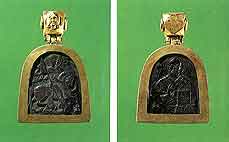
St. George and St. Nicholas. Pectoral icon. 14th century. Moscow. Obverse. Reverse |
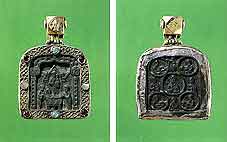
The Assumption of the Virgin, St. Nicholas. The Evangelists and Selected Saints. Pectoral icon. 1380s. Moscow. Obverse. Reverse
|
The flowering of miniature wood-carving was connected with the works of Avbrose who lived in the Trinity-St. Sergius Monastery in the second half of the 15th century. His art stands with the creations of the best icon-painters in expressiveness, deep content and superb technique. Complicated many-figured compositions appeared in fine miniature wood-carving for the first time. In 1456, Ambrose made the three-fold icon of walnut in a gold filigree reliquary to the order of the Trinity Monastery hegumen Vassian.
|
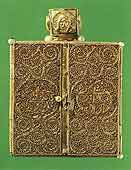
Folding icon. 1456. Work of Ambrose. Exterior |
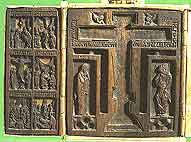
Interceding at the cross. Folding icon. 1456. Work of Ambrose. Exterior. Detail |
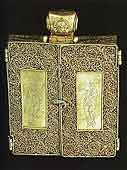
Reliquary. 1463. Work of Ambrose (?). Interior
|
|
Àmbrose carved lace-like miniatures and inserted them in rectangular reliquaries on both sides of the communion cross of walnut. The obverse depicts the Trinity, the Annunciation, the Nativity of Christ, Meeting of the Lord, Baptism, Transfiguration; the reverse shows Raising of Lazarus, Entering Jerusalem, Resurrection, Descent of the Holy Spirit to the Apostles, the Assumption of the Virgin, the Appearance of the Virgin to St. Sergius of Radonezh, Beheading of St. John the Baptist. The small panagia, carved in oak and set in a gilded silver filigree frame, reveals features characteristic of Ambrose works.
|
|
|

Communion cross. Second half of the 15th century. Obverse |

Communion cross. Second half of the 15th century. Reverse |
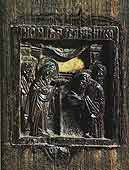
Communion cross. Second half of the 15th century. Detail |
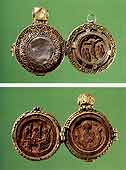
The Crucifixion, the Virgin of the Sign, the Trinity. Panagia. Second half of the 15th century |
|
|


